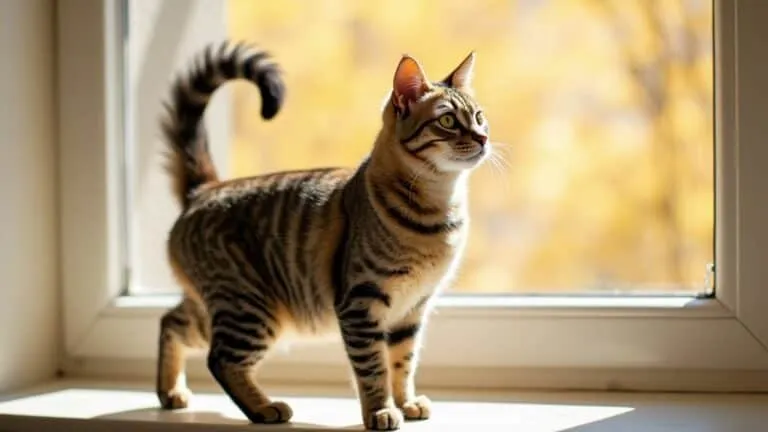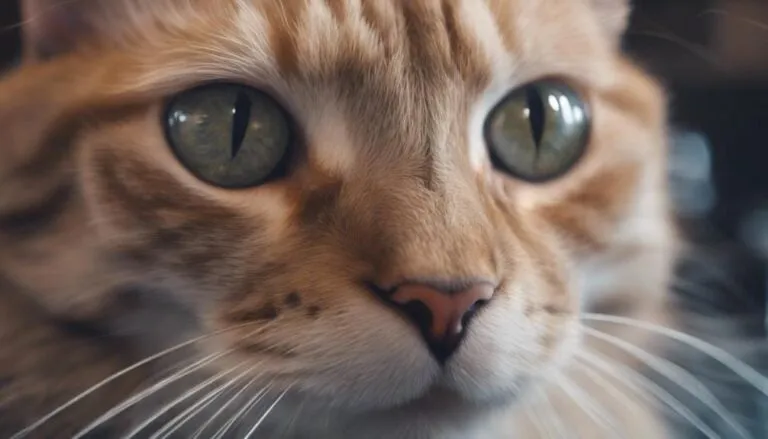The Best Fluffy Pancakes recipe you will fall in love with. Full of tips and tricks to help you make the best pancakes.

In the realm of feline perception, there exists a realm of mind-blowing secrets surrounding the mysterious world of cat vision. Their extraordinary ocular structure, consisting of rods and cones, grants them a unique perspective on the world around them.
While their exceptional night vision capabilities are well-known, their limited color vision adds an intriguing layer to their visual perception.
But what about their interaction with computer screens? Can they recognize images? Engage with videos? The answers to these questions lie in the fascinating realm of cat vision, offering a tantalizing glimpse into the uncharted territory of their relationship with technology.
Prepare to be captivated as we unravel the enigmatic secrets of cat vision and its enthralling connection to the virtual world.
Key Takeaways
- Cats have superior night vision and can track subtle movements due to their high number of rods.
- Cats have limited color vision, similar to color blind humans.
- Cats can see and react to what's on computer screens, but may struggle with small or precise items.
- Cats rely on both their vision and hearing when watching videos or engaging with visual stimulation.
Cat Vision and Computer Screens
When it comes to viewing computer screens, cats possess unique visual capabilities that allow them to perceive and interact with the content displayed, albeit with certain limitations. Cats have two types of photoreceptor cells: rods and cones.
While they have more rods than humans, giving them excellent night vision and the ability to track subtle movements, cats have limited color vision, similar to humans who are color blind.
The effect of screen time on cat eyesight is not well-studied, but it is important to consider the impact of screen brightness on cat vision. Excessive screen time or high screen brightness can potentially strain a cat's eyes and may cause discomfort.
Therefore, it is recommended to monitor screen time and adjust screen brightness to ensure the well-being of cats when they are exposed to computer screens.
Fun Activities for Cats With Computer Screens
Engaging cats in fun activities using computer screens can provide them with mental stimulation and entertainment. There are several options for interactive games and virtual hunting activities that can engage a cat's natural instincts and keep them entertained.
Here are three fun activities for cats with computer screens:
- Play cat videos: Cats can be fascinated by moving images on the screen, and playing cat videos can capture their attention and provide entertainment. There are a variety of videos available online that feature birds, fish, or other animals that cats enjoy watching.
- Interactive games: There are interactive games specifically designed for cats that can be played on computer screens. These games often involve chasing objects or catching virtual prey, allowing cats to engage their hunting instincts and providing mental stimulation.
- Virtual hunting: Virtual hunting games can simulate the experience of hunting for cats. These games typically involve moving objects or targets on the screen that cats can interact with, allowing them to satisfy their natural hunting behavior in a safe and controlled environment.
Mom Cats and Discipline
Moving on to the topic of Mom Cats and Discipline, it is important to understand that mother cats play a significant role in shaping the behavior of their kittens. Through various kitten training methods, mom cats use vocal cues and gentle bites or nips to communicate and correct their kittens' behavior. These disciplinary actions not only teach kittens boundaries but also help them develop essential social skills.
The benefits of discipline for cats are numerous. It allows them to understand appropriate behavior, establish routines, and learn to respect boundaries. Additionally, discipline helps kittens become well-adjusted adult cats, capable of interacting harmoniously with their human companions and other animals.
Mom cats' role in discipline is vital for the overall behavioral development of their kittens.
Cat Hearing and Dog Whistles
Cats possess a unique hearing range that allows them to perceive high-frequency sounds, including those emitted by dog whistles. This ability makes them responsive to training techniques that utilize sound. When it comes to cat hearing and dog whistles, it is important to understand the following:
- Cat Hearing Range:
- Cats have a broader hearing range than humans, ranging from 48 to 85,000 Hz.
- Their sensitivity to high-frequency sounds is due to the structure of their inner ear.
- Cats can perceive sounds that are inaudible to humans, such as ultrasonic frequencies.
- Training Cats with Sound:
- Some cat owners use dog whistles as a training tool to communicate with their pets.
- Dog whistles emit high-frequency sounds within a cat's hearing range, which can get their attention.
- Positive reinforcement techniques can be combined with sound cues to train cats effectively.
- Considerations:
- It's essential to use dog whistles responsibly and considerate of your cat's comfort and well-being.
- Not all cats will respond to dog whistles, as individual hearing capabilities may vary.
- Training cats with sound should always be done with patience, consistency, and positive reinforcement.
Different Types of Bengal Cats
Bengal cats are a distinct breed known for their various types, each characterized by unique coat patterns and colorations. These Bengal cat breeds showcase the beauty and diversity within the breed.
Spotted Bengal cats have distinct spots all over their coat, creating a striking and eye-catching appearance.
Marbled Bengal cats, on the other hand, have a unique swirling pattern on their fur, resembling the patterns found in marble.
Snow Bengal cats have lighter fur colors, reminiscent of the magnificent snow leopards.
Lastly, Rosetted Bengal cats exhibit rosette-shaped markings on their coat, which adds a touch of elegance and sophistication.
Each type of Bengal cat possesses its own charm and allure, making them truly captivating and extraordinary companions for cat lovers.
The Science Behind Cat Vision
The visual capabilities of cats are a result of their unique photoreceptor cells and specialized adaptations for optimal vision in different lighting conditions.
- Cats have a higher number of rods than humans, which allows them to see in low light and track subtle movements with precision.
- Their enhanced night vision gives them an advantage in hunting, as they can easily spot prey in the dark.
- Cats have limited color vision, similar to humans with color blindness, but they excel in detecting motion and contrast.
- Depth perception is crucial for hunting, and cats have binocular vision that helps them accurately judge distances.
- Their eyes are positioned forward, providing a wide field of view and enhancing their ability to focus on a target.
- Cat vision plays a vital role in hunting as it enables them to accurately assess the distance, speed, and trajectory of their prey, increasing their chances of a successful catch.
Enhancing Cat Vision With Proper Nutrition
With an understanding of the science behind cat vision, it is important to explore how proper nutrition can enhance their visual capabilities. A cat's diet plays a crucial role in maintaining the health of their eyes and optimizing their vision.
Providing cats with a balanced and nutrient-rich diet can have significant benefits for their eyesight. Essential nutrients such as omega-3 fatty acids, antioxidants, and vitamins A, C, and E are particularly important for maintaining healthy eyes. These nutrients support the structure and function of the eyes, protect against oxidative stress, and promote optimal visual acuity.
Additionally, a diet that includes high-quality protein sources can support the development and maintenance of the photoreceptor cells in a cat's eyes, helping to enhance their ability to see in low light conditions.
Frequently Asked Questions
Can Cats See the Images on Computer Screens in the Same Way Humans Do?
Cats have limited visual acuity and color vision compared to humans. While they can see images on computer screens, they may struggle with small or precise details. Cats rely on their sense of hearing and movement when watching videos.
How Do Mom Cats Discipline Their Kittens?
Mom cats discipline their kittens by using vocal cues, gentle bites, and nips to teach boundaries and correct behavior. Through these disciplinary actions, mom cats play a vital role in shaping their kittens' social skills and overall behavior.
Do Cats React Differently to Dog Whistles Compared to Dogs?
Cats and dogs have different auditory sensitivities. Cats can hear high-pitched sounds, including dog whistles, but their reactions may vary. Some cats may display curiosity or alertness, while others may be indifferent. It is important to consider the individual cat's comfort when using dog whistles.
What Are the Different Types of Bengal Cats and Their Unique Characteristics?
There are various types of Bengal cats, each with unique characteristics. Spotted Bengals have distinct spots, marbled Bengals have swirling patterns, snow Bengals have lighter fur, and rosetted Bengals have rosette-shaped markings. Bengal cats are known for their active and playful nature.
Is It Possible to Enhance a Cat's Vision Through Proper Nutrition?
Enhancing feline vision through proper nutrition is possible. Nutrients like vitamins A and taurine play crucial roles in maintaining cat eyesight. However, it is essential to consult with a veterinarian for specific dietary recommendations to ensure optimal effects on cat eyesight.
Conclusion
In conclusion, the world of cat vision is truly mesmerizing, with their intricate ocular structure allowing them to navigate the darkness with exceptional night vision capabilities.
While their color vision may be limited, their ability to recognize images and engage with videos on computer screens is a testament to their unique perception.
By exploring the possibilities of visual stimulation and providing proper nutrition, we can enhance their already remarkable vision and deepen our understanding of our feline companions.








